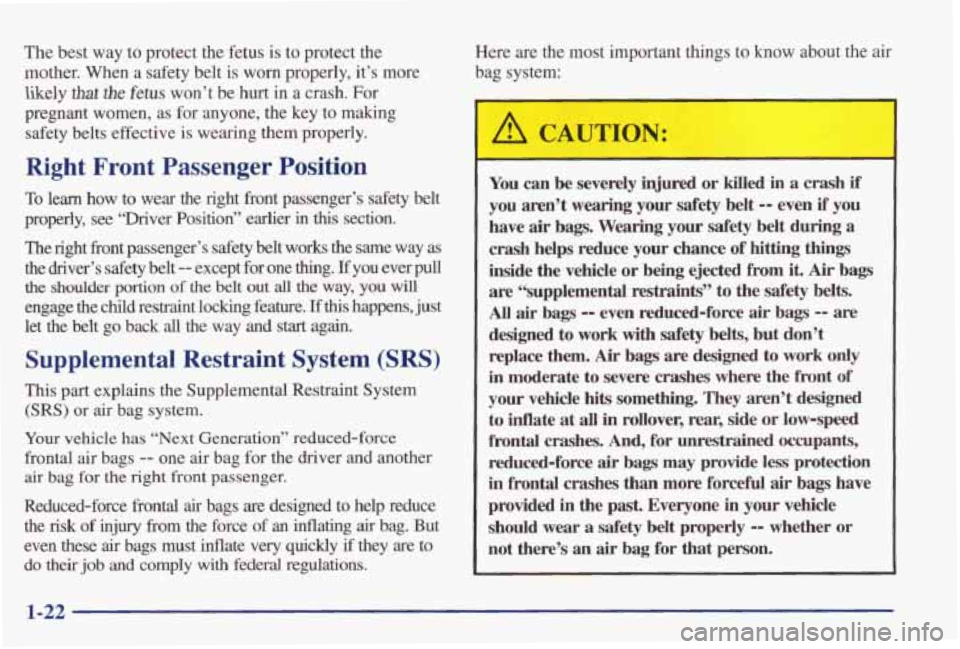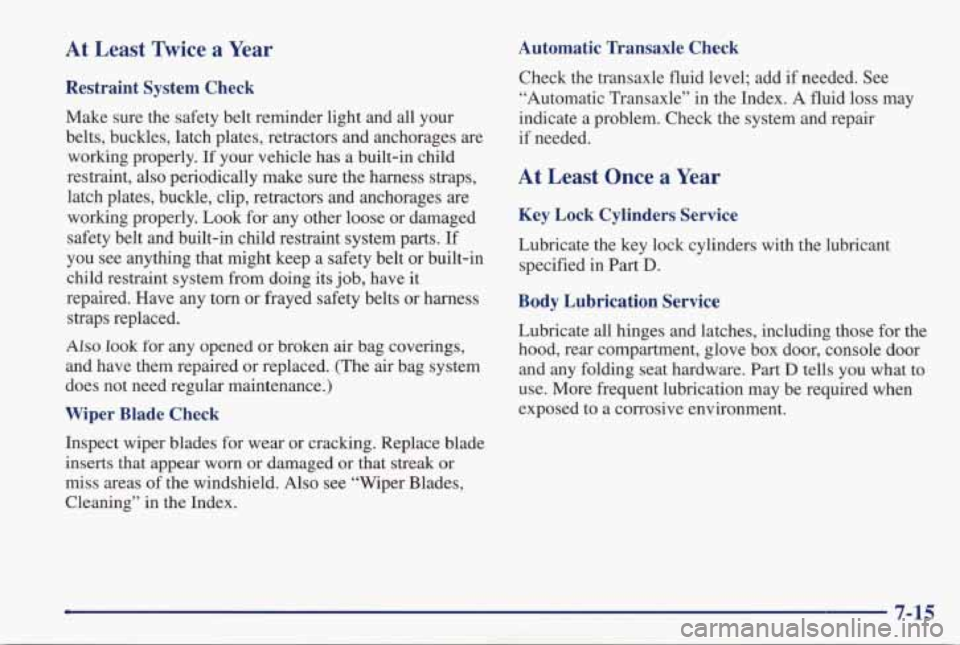Page 29 of 402

The best way to protect the fetus is to protect the
mother. When a safety belt is
worn properly, it’s more
likely
that the fetus won’t be hurt in a crash. For
pregnant women, as for anyone, the key to making
safety belts effective
is wearing them properly.
Right Front Passenger Position
To learn how to wear the right fiont passenger’s safety belt
properly,
see “Driver Position” earlier in this section.
The right front passenger’s safety belt works the same way
as
the driver’s safety belt -- except for one thing. If you ever pull
the shoulder portion of the belt out all the way, you will
engage the child restraint locking feature. If this happens, just
let the belt go back
all the way and start again.
Supplemental Restraint System (SRS)
This part explains the Supplemental Restraint System
(SRS) or air bag system.
Your vehicle has “Next Generation” reduced-force
frontal
air bags -- one air bag for the driver and another
air bag for the right front passenger.
Reduced-force
fiontal air bags are designed to help reduce
the risk of injury from
the force of an inflating air bag. But
even these
air bags must inflate very quickly if they are to
do their job and comply with federal regulations. Here are the most important things to
know about the air
bag system:
’
A CAUTION: I
You can be severely injured or killed in a crash if
you aren’t wearing your safety belt -- even if you
have air bags. Wearing your safety
belt during a
crash helps reduce your chance of hitting things
inside the vehicle or being ejected from it. Air bags
are %pplemental restraints” to the safety belts.
All air bags -- even reduced-force air bags -- are
designed to work with safety belts, but don’t
replace them.
Air bags are designed to work only
in moderate to severe crashes where the front of
your vehicle hits something. They aren’t designed
to inflate at
all in rollover, rear, side or low-speed
frontal crashes.
And, for unrestrained occupants,
reduced-force
air bags may provide less protection
in frontal crashes than more forcefid air bags have
provided
in the past. Everyone in your vehicle
should
wear a safety belt properly -- whether or
not there’s
an air bag for that person.
Page 54 of 402
5. Push the latch plate (F) into the buckle until it clicks.
Be sure
the buckle is free of any foreign objects that
may prevent you from securing the latch plates. If
you can’t secure a latch plate, see your dealer for
service before using the child restraint.
6. In a single motion, pull the other side of the harness
all the way out. Keeping the harness pulled all the
way out, place
it over the child’s shoulder.
4. Select only one side of the harness. Pull the lap part
of the harness out, and place the harness over
the
child’s shoulder.
If both sides of the harness are pulled out, the lap
parts will lock. If the lap parts lock, let both sides of
the harness
go back all the way so each side will
move freely
again. Then repeat this step, pulling
only one side of the harness out.
Page 55 of 402
7. Push the latch plate into the buckle until it clicks.
Pull on both latch plates to make sure they are secure. A
green indicator will show in each latch plate window (G).
If the harness locks before the latch plate reaches the
buckle, let the harness go all the way back so it will move
freely again. Then repeat Steps 6 and 7. Be sure to keep
the harness pulled all the way out until you buckle it.
Once both sides of the lap-shoulder harness are pulled
out
of the retractor and buckled, the harness will lock.
8. Now fasten the left and right halves of the shoulder
harness
clip together. The indicator window (H) on
the clip will show green when the two halves are
fastened together. The purpose
of this clip is to help
keep the harness positioned
on the child’s shoulders.
1-48
Page 56 of 402
An unfastened shoulder harness clip won’t help
keep the harness in place on the child’s shoulders.
If the harness isn’t on the child’s shoulders, it
won’t be able to restrain the child’s upper body
in a sudden stop or crash. The child could be
seriously injured. Make sure the harness clip is
properly fastened.
9. On both sides of the harness, pull up on the lap part a
little to be sure it’s locked.
If the harness isn’t locked, or if it becomes too tight,
unfasten the harness clip. Then unlatch the harness
by pushing the button
on the buckle, and let both
sides
of the harness go all the way back so they will
move freely again. Then, repeat Steps 4 through 8.
If the harness still doesn’t lock, don’t use the child
restraint. See your dealer to have the built-in child
restraint serviced.
1-49
Page 66 of 402
2. Pick up the latch plate, and run the lap and shoulder
portions of the vehicle’s safety belt through or
around the restraint. The child restraint instructions
will show
you how.
If the shoulder belt goes in front of the child’s face or
neck, put it behind the child restraint.
L
4. Pull the rest of the shoulder belt all the way out of
the retractor to set the lock.
3. Buckle the belt. Make sure the release button is
positioned so you would be able to unbuckle the
safety belt quickly if you ever had to.
1-59
Page 71 of 402
5. Pull the rest of the shoulder belt all the way out of
the retractor to set the lock.
6. To tighten the belt, feed the shoulder belt back into the
retractor while you push down on the child restraint.
You may find it helpful to use your knee to push down
on
the child restraint as you tighten the belt.
directions to be sure
it is secure.
7. Push and pull the child restraint in different
To remove the child restraint, just unbuckle the vehicle’s
safety belt and let it
go back all the way. The safety belt
will
move freely again and be ready to work for an adult
or larger child passenger.
1-64
Page 79 of 402

Door Locks
1
I A CAUTION:
Unlocked doors can be dangerous.
Passengers
-- especially children -- can easily
open the doors and fall out. When
a door is
locked, the inside handle won’t open it.
Outsiders can easily enter through an unlocked
door
when you slow down or stop your vehicle.
This may not be so obvious: You increase the
chance of being thrown out of the vehicle in a
crash
if the doors aren’t locked. Wear safety belts
properly,
lock your doors, and you will be far
better off whenever you drive your vehicle.
There are several ways to lock and unlock your vehicle.
Front Door
To unlock either front door from outside the vehicle
with your key, insert it fully into the door key cylinder
and turn
it toward the front.
You can lock either front door from outside the vehicle
with your key
by inserting it fully into the door key
cylinder and
turning it toward the rear.
To unlock either front door from inside the vehicle, push
the lock lever forward.
To lock either front door from inside the vehicle, push
the lock lever back.
Page 360 of 402

At Least Twice a Year
Restraint System Check
Make sure the safety belt reminder light and all your
belts, buckles, latch plates, retractors and anchorages are working properly. If your vehicle has
a built-in child
restraint, also periodically make sure the harness straps, latch plates, buckle, clip, retractors and anchorages
are
working properly. Look for any other loose or damaged
safety belt and built-in child restraint system parts. If
you see anything that might keep a safety belt or built-in
child restraint system from doing its job, have it
repaired. Have any torn or frayed safety belts or harness
straps replaced.
Also look for any opened or broken air bag coverings,
and have them repaired or replaced. (The air bag system
does not need regular maintenance.)
Wiper Blade Check
Inspect wiper blades for wear or cracking. Replace blade
inserts that appear
worn or damaged or that streak or
miss areas of the windshield. Also see “Wiper Blades,
Cleaning” in the Index.
Automatic Transaxle Check
Check the transaxle fluid level; add if needed. See
“Automatic Transaxle” in the Index. A fluid loss may
indicate a problem. Check the system and repair if needed.
At Least Once a Year
Key Lock Cylinders Service
Lubricate the key lock cylinders with the lubricant
specified in
Part D.
Body Lubrication Service
Lubricate all hinges and latches, including those for the
hood, rear compartment, glove box door, console door
and any folding seat hardware.
Part D tells you what to
use. More frequent lubrication may be required when
exposed to a corrosive environment.
7-15